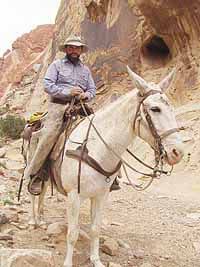| Jeff Newland, owner and manager of JNC Trailrides and Outfitters of Green River is pictured on top of Molly, one of his pack mules. Newland not only knows the country like the back of his hand, but is full of stories about the history of the area. The other pictures on this page portray the Smith Ranch homestead, nestled on the Eastern edge of the San Rafael Swell. This homestead lies just west of the Spanish Trail that was used as a trading route from New Mexico to California between the 1820’s and the late 1840’s. |
There is so much historical significance in Eastern Utah and only a handful of early travelers and pioneers documented their efforts as they molded the country we know today as Emery and Carbon counties. They literally carved out trails, homesteads and mines from the cliffs of one of the most beautiful parts of America. I had the opportunity last week to visit a small portion of this area in Southern Emery County with Jeff Newland, who manages a pack company out of Green River. On horses we spent the day along the Eastern edge of the San Rafael Swell and got only a glimpse of the vast country.
Historically, one small piece of the early development happens in the early 1800’s as traders from Santa Fe, New Mexico developed a commercial route through Western Colorado and up into Eastern and Southern Utah on their way to California. According to historians, although many of the documented articles differ slightly, the trail was known as the Spanish Trail. Think of the Trail as an early day trucking route before the times of freeways and train tracks.
This 1,120 mile route entered Utah somewhere northeast of Monticello and headed northwest into the Moab area crossing the Colorado River. It made its way towards Green River in what is now Grand County. Just northeast of the townsite of Green River is a sign indicating the location of the crossing of the Spanish Trail through a shallow part of the Green River.
According to locals the crossing tied in with a large island in the Green River. This location lies in the shadows of the picturesque Book Cliffs. From this point the traders trudged northwest into what is now Emery County heading towards the north end of the San Rafael Swell.
Green River has been a crossroad of several historical pioneers whose documents helped preserve the history of the region. These include the famous Gunnison survey, the Mormon party headed by Oliver Huntington and John Wesley Powell. The local museum in Green River, named after the famous Powell, has an incredible amount of history of the area including the Spanish Trail and its significance to Southern Emery County.
The horseback traders headed almost directly northwest into the Swell and although documents differ on the exact route, it weaved its way northwest between what is now Highway 6 and the San Rafael Swell, following the washes. Regardless of the exact route it seems to have followed the watering holes, which were few and far between in this vast desert country. Depending on how close to the Reef the trail went it must have been quite a site to see the buttes, pinnacles and mesas in the not-so-far west as the horsemen made their way through the washes and rocks. Stories have it that the trail took the northern route into Utah because of the difficulty in crossing the Grand Canyon and hostile Indian tribes in Arizona.
From all accounts the two significant springs or watering holes along the eastern edge of the Reef include Trail Spring and Big Holes. From Green River Springs, the trail emerges from the sands of the Lost Spring Wash at Cement Crossing, on an unused grade of the Denver and Rio Grande railroad bed that was built across the northern part of the Swell in the early 80’s a direct route from Green River to Price.
Just east of this section of the Trail is the Smith Ranch homestead, still part of the ranching family today. Although weathered in time, portions of the buildings still stand, including the ranch house, corrals, root cellars, and outbuildings. The homestead was built along the side of a wash and is located in a beautiful setting looking out towards the Book Cliffs on the East, nestled and protected from the reef on the West.
The Trail continues its way toward Big Holes in Pack Saddle Gulch. Beyond this area the trail emerges into an open area passing between the broken rim of the San Rafael River and the thousand-foot-cliffs of Cedar Mountain on the right. This course angles its way through the northern Reef until it drops into Huntington Creek and Castle Valley.
It’s a small bit of history preserved in a vast wilderness in remote Emery County. Used between 1829 and 1848 the Spanish Trail was really the beginning of interstate commerce as horse traders brought their wares west to the California coast.

